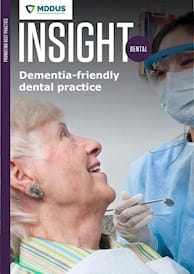No matter what sphere of healthcare you work in, the reality of dealing with the public means that complaints will follow.
Between 2020 and 2021, the number of written complaints to NHS England was 170,130, equivalent to 300 per 100,000 head of population. Just over 86,100 were about primary care, with almost half not upheld.
Of the 31,411 that related to either a GP or dentist, only 4,041 related directly to a dentist, 1,312 related to dental admin staff and 1,462 to practice managers. By far the largest complainers were patients in the 26 to 55 year age bracket, with clinical treatment being one of the main sources of complaint.
Anecdotally, we all believe that complaints have risen, yet NHS England statistics show that complaints about dental practices in 2020/21 actually reduced by 42.4 per cent compared 2019/20 figures – although this might simply be a reflection of the amount of dentistry undertaken in 2020. Concerns to the Dental Complaints Service remained static between 2019 and 2020.
Is that how it feels? Are complaints less of a worry to dental care professionals? Speaking regularly to MDDUS members my answer would be a resounding no! Complaints aren’t going away – despite the statistics – and they remain a major source of anxiety for an already burdened profession.
Organisations often speak of “complaints handling”. But if all we do is handle complaints, are we simply learning to shuffle paper in line with timescales? Shouldn’t the focus be on “complaint resolution” and not just running around trying to get a response out within a deadline?
Complaint or feedback
A complaint can be defined as “an expression of dissatisfaction about an act, omission or decision of the provider, either spoken or written, and whether justified or not, which requires a response”.
Too often when a patient voices an opinion, they are met with the reply: “put it in writing”. This instantly sets us off on the wrong path.
A proper first response to a patient expressing what might be taken to be criticism is to consider: is this feedback or a complaint? Feedback is something we can act on immediately: you speak and we listen and make changes to improve our services – unlike a complaint which starts a formal process.
A proportion of patients simply want to point out that some part of their patient journey in the practice is problematic, for example that parking is difficult. This doesn’t mean they want to go through a formal complaint process. Practices can have quick wins by utilising feedback and we will discuss this in part 2 of this article, in the next issue of Insight Dental.
First response
So what if the patient does want to complain? “Put it in writing” is still not the best response. As soon as we direct a patient away from the practice to hit a keyboard or put pen to paper, they are less likely to feel we truly care, which may only add to their concerns. A better option is to offer to listen to the patient’s concerns somewhere private (chaperoned).
The goal is not to give answers at this stage but to listen. You should avoid the temptation to butt in even if they say something with which you disagree. Simply take the details and at the end reflect back:
Thank you for taking time to explain your concerns, it’s important to us that we have fully understood what you’ve said and that we haven’t missed anything out. I understand from what you’ve said your concerns are...
The patient then needs to know who will manage the complaint, and how and when you will provide a response. Ask the patient how they want the response given: letter, email, call or meeting. In an ideal world, any member of the patient-facing team should be able to collate a verbal complaint, but this needs the whole team to be trained. Whatever you do, if a patient is willing to talk, be willing to listen.
Acknowledging the complaint
With written complaints, the first response can determine whether the issue grows arms and legs and escalates rapidly, or is resolvable. Too often complaints arrive with the GDC almost as soon as the patient has received an acknowledgement from the practice.
Delay in providing a well-drafted acknowledgement can swiftly put paid to resolving the complaint. Time limits are set out for each UK jurisdiction but try to acknowledge the concerns within a day at best, but ideally no longer than three days.
The key is to let the complainant know you have actually read the concerns and care. A response that says “I received your complaint; we are sorry you feel unhappy about your treatment and we will respond in 10 days” really won’t cut it.
The sad-but-glad technique allows you to show you care and indicates that expressions of concern are welcome and will be actioned. Below is a template acknowledgement:
Dear X
Thank you for your email of 16 September received on 27th September 2022. I am sad to read/hear/see [don’t say ‘you feel’] that your visit to our practice was less than you might have hoped for. I am however glad that you have let us know, as we take all concerns very seriously because they help us, where necessary, to improve the way that we care for all our patients.
I have read your letter with great care and I understand that you are unhappy about/ have experienced…………………………..
As the practice complaint handler I plan to investigate your concerns by reviewing the records made of your visits with us, and speaking to the clinical and support staff involved in your care.
I should be able to provide you with a response by…….. If for any reason my investigation will take longer I will let you know. My response would ordinarily be to the email address you provided. If you would like the response by post, or an alternative email address please let me know.
I would welcome the opportunity to discuss your concerns with you, and I am usually available ………………..
I enclose a copy of our practice complaints leaflet for your reference.
Kind regards
Practice Complaint Handler
Telephone number
Investigation and drafting a response
You then need to decide what and who the complaint is about. An investigation may involve a number of practice staff depending on the nature of the complaint. In general you should:
- Current or former dentist at the practice: send a copy of the complaint and ask for a response involving their indemnity/insurer. Provide a deadline.
- Employed staff: check if they have separate indemnity/insurance cover. If not, speak to them directly but ensure questions are open-ended and don’t answer for them.
- Practice building or health and safety issue: refer to the owner/contract holder.
Record all aspects of your investigation in the complaint file, not in the clinical records. The local ombudsman may request a copy of the complaint file.
Keep an open mind, speak to each person involved and consider both the reception and clinical records. Ask yourself: were there any precipitating factors that need to be taken into account? Think about how the complainant feels and then draft but do not send the response. Never respond to a complaint without involving the person to whom the complaint refers.
You should check that any response is concise, factual and explains how you have investigated the complaint. Set out what did happen, what should have happened and, if necessary, apologise. An apology is not an admission of liability.
Describe any learning and any actions that flow from the concerns raised and, if necessary, what remedy is offered. At the end do the “granny test”: if this were a complaint by your granny would she be happy with the response.
Patients should be directed in the letter where to send further correspondence if they are unhappy with the way in which their concerns have been handled. Provide contact details for:
- NHS complaints: devolved ombudsman offices – Parliamentary and Health Service Ombudsman (England), Scottish Public Services Ombudsman, Northern Ireland Public Service Ombudsman, Public Services Ombudsman for Wales
- Private: Dental Complaints Service.
Never leave the complainant to Google the answer – direct them.
MDDUS would always recommend you involve us before sending any response to a patient.
Follow-up letter
If what we are really seeking is resolution rather than ditching anyone who raises their head above the parapet, a follow-up letter to the patient (hard as it is) to enquire whether their concerns are resolved can preserve the dentist-patient relationship. It may not be appropriate in all cases, but where a valued patient raises concerns it can go some way to mending the relationship.
Staff wellbeing
It’s also important to consider the impact any complaint can have on you and your team. We all need support, and even small criticisms can fall hard when we are under pressure. Take time out, reflect, check in on those involved and if necessary direct them to help (see YourHalo below).
Make the most of any learning and publish (practice website, newsletter, notice board, etc) changes that might have been made to the way you run the practice as a result of anonymised patient feedback (i.e. You spoke, We listened, We acted).
This can show your patients that you are a listening practice and also help reduce complaints, which we will discuss in part 2 of this article in the next issue of Insight Dental.
This page was correct at the time of publication. Any guidance is intended as general guidance for members only. If you are a member and need specific advice relating to your own circumstances, please contact one of our advisers.
Read more from this issue of Insight Dental

Save this article
Save this article to a list of favourite articles which members can access in their account.
Save to library


